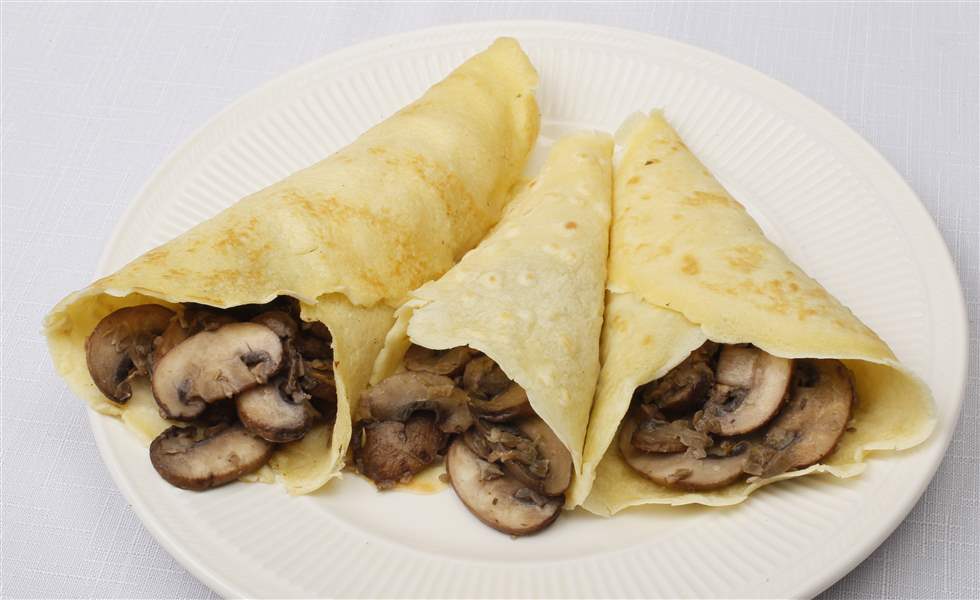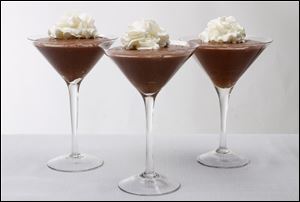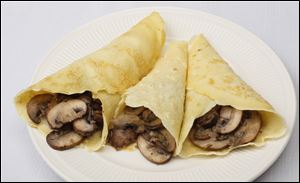
French cooking: All it takes is a little inspiration
10/9/2012
Mushroom crepes.
The Blade/Dave Zapotosky
Buy This Image

Chocolate mousse.
There is something about the art of Edouard Manet that makes you hungry for French food — preferably served at a charming corner bistro, or perhaps at a marble-topped bar, or even a luncheon on the grass.
A major exhibition of 40 portraits by the great early Impressionist painter is now on display at the Toledo Museum of Art. And by the transitive property of culinary equivalents, that means a lot of people will be hungry for a lot of French food.
French food, of course, is often considered the finest, best, and most refined food on the planet. The problem for the home cook is that French food is often complicated to make. To do it right requires a certain amount of skill and usually a considerable stretch of time.
But you’ve seen the portraits. You’re inspired. In the back of your mind, you’re hearing a wistful accordion play “La Vie en Rose.” You want to cook something French.
The good news is, it doesn’t have to be hard. Sure many French dishes require complex sauces, intense reductions, and delicate pastry creams. But some French preparations are relatively easy, more or less. Some take no more time to make than many other foods. And so we set out to make a number of them.
We started with crepes. Crepes are as French as berets, they are as French as all those knit shirts with the horizontal blue and white stripes. And they are still commonly found throughout France, which is more than you can say about berets.
The crepes themselves are easy to make — just mix together a handful of common ingredients, let them sit awhile in the refrigerator, and then spoon out the batter, a couple of tablespoons at a time, on a somewhat hot pan. The intriguing part comes with the fillings.

Mushroom crepes.
Julia Child, bless her, recommends using any filling you might put in an omelet (creamed chopped spinach or cooked chopped broccoli sautéed in butter; mushrooms, chicken livers or scallops sautéed in butter with shallots and seasonings; creamed lobster, shrimp or crab; green and red peppers sautéed with onions, garlic, and herbs; sautéed diced potatoes, with or without bacon and onions; or fresh tomato fondue).
But we had in mind a preparation we had in Paris: sautéed mushrooms and shallots with melted Emmental cheese. Serve it in a waxed-paper cone, close your eyes, and you’re on the streets of Paris on a misty night.
For a simple yet luxurious first course, we made up a batch of cocotte eggs, named for the ramekins in which they are heated and served. Cocotte eggs are similar to coddled eggs, which are cooked at a temperature just below boiling until they are decadently smooth and creamy. The eggs are cooked in ramekins which have been placed in hot water in the oven, then topped with a light snipping of chives and a drizzle of crème frâiche.
So far, so great. But what makes cocotte eggs so particularly amazing is what Laura Calder calls the “surprise.” In the bottom of each ramekin, she places an unexpected bit of something — some crumbles of blue cheese, perhaps, or an enticing slice of silken smoked salmon. We made ours with a few leaves of tarragon and some grated Parmesan cheese, which presented a savory counterpoint to the creamy eggs.
Serving them with buttered toast points to be dipped into the eggs while eating them completes the experience.
For our main course, we made a dish both super-easy and prototypically French: chicken with a mushroomcream sauce. Typically, the recipe would use morels, because there is nothing more ambrosial on this earth than a sauce of cream and morel mushrooms, particularly when it also includes a little reduced dry sherry. However, our favorite local purveyor of dried morels is selling them for $25 an ounce, so instead we used a handful of fresh crimini mushrooms, sliced thin.
It may not be quite as ambrosial as the sauce with morels, but it is close enough and it is much more affordable. If we were making a French dinner for guests, though, we might have sprung for the morels. It would depend on how much we liked the guests.
And speaking of saving money, we bought a whole chicken and cut it into parts ourselves, and then skinned and boned the parts. It did give us a bunch of bones to freeze for the next time we make stock, and we saved a considerable amount of cash, but it did take up a fair stretch of time. Buying boneless, skinless chicken pieces might be the way to go, if you can afford it. For dessert, we decided to make two dishes because, well, we like dessert. Both are classics from French kitchens.
Our lemon tart requires few ingredients and little time, though, to be honest, a pretty fair amount of whisking. But it isn’t vigorous whisking; it can be slow and leisurely, just a way to keep lemons, eggs, and sugar from burning while turning them into a smooth, creamlike filling. As was the case with the eggs cocotte, the filling is cooked (and whisked) in a pan set in water that is hot but not boiling.
If the filling is too tart for your taste, you can sweeten it up a bit merely by serving it a dollop of whipped cream on top.
Incidentally, we cheated a little when we made ours. If you want, you can make a tart crust yourself, but in the interest of saving time we just bought one from the store. It’s not the same thing, we know, or at least it doesn’t taste the same, but the pre-made crust made life that much easier and better.
And with the time we saved, we made a chocolate mousse. Before the creme bruléeification of America, the chocolate mousse was considered to be the quintessential French dessert. You don’t see them much anymore, but they are just as velvety, light, and smooth as ever. We whisked ours, but only because we like the sense of organic accomplishment that provides. A mixer will work just as well. We melted chocolate in a double boiler, separately whisked a bunch of egg whites and egg yolks, added a stick and a half of butter (we said it was velvety, light, and smooth, we never said it was healthy), threw in a couple of shots of orange liqueur to boost the flavor, and folded it all together.
M . Manet would be proud.
RECIPES
Crepes
2 1/4 cups milk
4 large eggs
1/2 teaspoon salt
4 tablespoons melted butter
2 cups all-purpose flour
2 tablespoons softened butter
Cook’s note: If making sweet crepes for dessert, use 1/4 cup sugar. Fill sweet crepes with ice cream (and drizzle chocolate sauce on top), sautéed apples, ricotta cheese or anything else you can think of.
Put milk, eggs, salt, optional sugar (if making sweet crepes), and melted butter into a large bowl or blender, and mix, whisk or blend together briefly. Add flour, and mix, whisk or blend until combined. Cover and refrigerate at least 1/2 hour or overnight.
To cook individual crepes, brush pan over medium heat with a small amount of softened butter. For large crepes, pour out about 1/4 cup of batter and tilt pan to spread it fully around the pan; for smaller crepes, use about 2 tablespoons of batter. Cook until bottom is brown, about 1 minute, then flip and cook until the other side is done.
Stack crepes when done and use as needed; they can be kept refrigerated for 2 days. Fill with a filling of your choice, or use the one below.
Yield: 16 large crepes or 32 small ones
Source: Vita-Prep Recipes and Techniques
Mushroom-Emmental Crepe Filling
1/2 tablespoon butter
1 shallot, finely chopped
5-6 crimini mushrooms, sliced thick
Pinch thyme
Salt and pepper
1 egg, beaten, optional
1/3 cup shredded Emmental cheese
Melt butter in a pan over medium heat, add shallots, and cook until translucent, about 2 minutes. Add mushrooms, thyme, and salt and pepper, and sauté until mushrooms are cooked, 5 minutes.
Reheat 1 large crepe or 2 small crepes in a pan over medium heat and brush with the egg, if using. Sprinkle with cheese. When the optional egg is nearly cooked and the cheese nearly melted, sprinkle with the mushrooms. Cook until the cheese is fully melted. Serve either rolled up like a traditional crepe or in a cone of waxed paper.
Yield: 1 large or 2 small crepes
Chicken with Mushroom Cream Sauce
1 (3½ pound) chicken OR 2 skinless, boneless breasts, thighs, and legs
½ teaspoon salt
¼ teaspoon pepper
2 tablespoons sweet butter
½ cup dry white wine
2 tablespoons thinly sliced shallots
½ cup dry sherry (not sweet sherry)
6-8 crimini mushrooms, sliced thin (see cook’s note)
1 cup heavy cream
Cook’s note: The original recipe calls for 1 ounce of dried morels. If you want to splurge, use them — they will be much better. Soak them in water at least 15-20 minutes. If whole, slice them lengthwise. Cut off the tips of the stem. Discard the soaking water, which will have sand in it, and wash them again, several times if necessary, until there is no sand left in the bottom of your bowl. Drain and press gently to extrude some of the water.
If using the whole chicken, separate it into serving pieces, remove all skin, and pull or cut the bones from the meat.
Cut each breast into 2 pieces. This should leave you 8 pieces (4 breast pieces, 2 thighs, 2 legs). Season with the salt and pepper.
Melt the butter in a skillet over medium heat. When foaming, place the pieces of chicken in it. Gently sauté for 4 minutes — 2 minutes on one side and then 2 minutes on the other side. The chicken should be browned lightly, but a crust shouldn’t form on the flesh. The butter should be foaming nicely, but not burning.
Add the white wine, cover and simmer another 2 minutes, then remove the lower 2 pieces of the breasts, which require less time to cook (check with a knife to make sure they are done). After another 2 minutes, remove the other 2 pieces of white meat. Leave the dark meat simmering for another 5-6 minutes, check to see if it is done, then remove and set aside with the breast meat. Add the shallots to the pan drippings for about 1 minute. Add the sherry, bring to a boil and reduce on high heat for 2-3 minutes or until the mixture is almost completely reduced.
Add the mushrooms, stir, and cook for 1 minute. Add the cream. Bring to a boil and reduce about 1 minute on high heat. The sauce should be glossy and should just coat a spoon. Add salt and pepper to taste. Reduce the sauce another 1-2 minutes, pour over the chicken, and serve immediately.
Yield: 4 servings
Source: La Methode, by Jacques Pepin
Classic Chocolate Mousse
6 ounces semisweet chocolate
4 tablespoons strong coffee
4 eggs, separated
1/4 cup orange liqueur (see cook’s note)
3/4 cup PLUS 2 tablespoons sugar, divided
1 1/2 sticks unsalted butter (12 tablespoons)
Cook’s note: Popular orange liqueurs include Grand Marnier and Cointreau.
In a double boiler, melt chocolate in the coffee.
Meanwhile, in a bowl beat together the 4 egg yolks and the orange liqueur, gradually adding the 3/4 cup sugar. Continue beating until pale yellow and it “forms the ribbon” (a bit dropped from the beater forms a fat, slowly dissolving ribbon on the surface). Set the bowl over a saucepan of barely simmering water and continue beating 4-5 minutes until it is foamy and warm to your finger. Remove from heat and beat over a bowl of cold water (or in a standing mixer) until it is cool and thick and again forms the ribbon.
When the chocolate is melted and still over the heat of the double boiler, cut the butter in rough slices and smoothly blend it in. Fold this chocolate into the egg-yolk mixture. Beat the 4 egg whites to soft peaks, add the remaining 2 tablespoons of sugar, and beat to stiff, shining peaks. Stir a quarter of this mixture into the yolks and chocolate, and delicately fold in the rest.
Turn the mousse into a serving dish, individual cups or pots de creme. Cover and chill for several hours (the mousse will keep in the refrigerator for several days). Serve with whipped cream.
Yield: 6-8 servings
Source: Julia’s Kitchen Wisdom, by Julia Child
Cocotte Eggs
2 teaspoons “surprise” (see cook’s note)
2 eggs
2 teaspoons crème fraîche
Salt and pepper
A scattering of chopped fresh chives
Cook’s note: For a “surprise,” use crumbled blue cheese, smoked fish, a few truffle shavings, leaves of tarragon, or a treat from your own imagination.
Preheat the oven to 375°.
Into the bottom of each of two buttered 1/2-cup ramekins, put a spoonful of “surprise.” Gently crack an egg on top. Top with a spoonful of crème fraîche. Season with salt and pepper. Sprinkle with the chives.
Set the ramekins in a baking dish, and pour in hot water to come halfway up the sides of the ramekins. Bake until the egg is cooked but still jiggling, 5-7 minutes. Serve with buttered toast fingers for dipping.
Yield: 2 servings
Source: French Taste, by Laura Calder
Lemon Tart
1 pie crust, homemade or store-bought
3 eggs PLUS 1 yolk
3/4 cup sugar
3/4 cup fresh-squeezed lemon juice (3-4 lemons)
Grated zest of 1 lemon
1 stick butter, diced and well chilled
Cook the pie crust according to directions.
Bring a kettle of water to a boil. Put a small mixing bowl in a large saucepan and put the eggs, yolk, and sugar in the small bowl. Whisk energetically to combine and then whisk in the lemon juice and zest. Pour the boiling water into the saucepan so that it reaches halfway up the outside of the mixing bowl (if you don’t have enough boiling water to reach this level, just add some hot water from the tap).
Put the saucepan over low heat and cook for 25 minutes, whisking fairly constantly until you have obtained a smooth, thick cream. Turn up the heat and whisk in the cold diced butter. Continue to whisk on this livelier heat. Pour the mixture into a bowl and allow it to cool. If you need to cool it quickly, put the bowl in a basin or large bowl filled with cold water that reaches halfway up the side of the bowl.
Pour the lemon cream into the cooked crust and smooth its top with a spatula. The tart is ready to serve.
Yield: 8 servings
Source: Adapted from The Complete Robuchon, by Joël Robuchon
Contact Daniel Neman at: dneman@ theblade.com or 419- 724-6155.